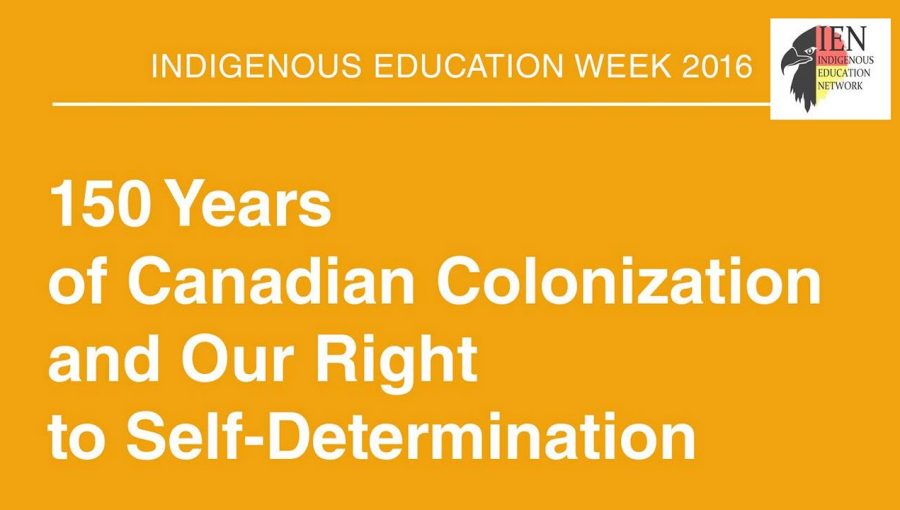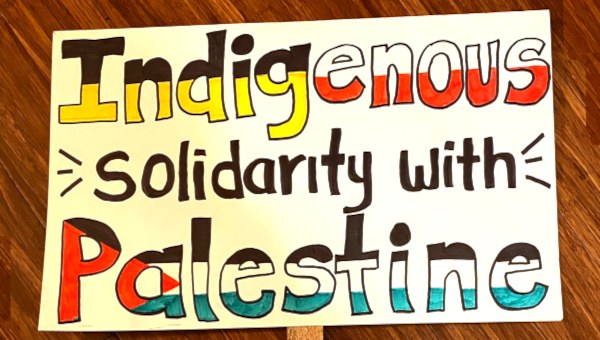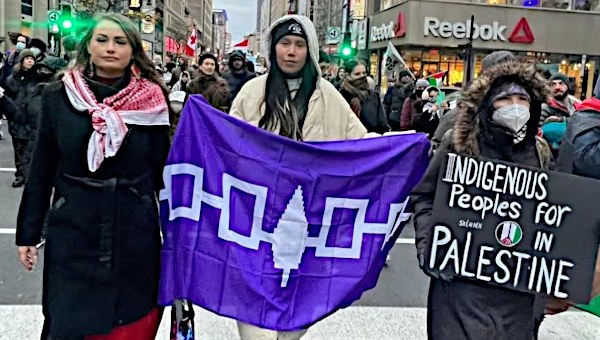The blossoming of the Idle No More movement signals the return of native resistance to the political and social landscape of Canada and Quebec. With its origins in Saskatchewan in October 2012, this mass movement has taken on the federal government and more specifically the adoption of Bill C-45. Its origins lay not in the work of established organizations such as The Assembly of First Nations (although the AFN fully supports the initiative), but in a grassroots mobilization that has arisen in several parts of the country. This process echoes other recent citizen mobilizations such as the student carrés rouges in Quebec and the worldwide Occupy movement.
 Bill C-45 is perceived by native people as an attempt to further weaken their already limited powers to resist the invasion of their lands and the continuing exploitation of their natural resources. In the eyes of these communities, this adds to a long list of initiatives and legislation put forward to undermine their autonomy.
Bill C-45 is perceived by native people as an attempt to further weaken their already limited powers to resist the invasion of their lands and the continuing exploitation of their natural resources. In the eyes of these communities, this adds to a long list of initiatives and legislation put forward to undermine their autonomy.
In neo-conservative circles, the existence of First Nations peoples is seen as an anachronism, best relegated to the past. Their future, if indeed they do have one, lies in assimilation into Canadian society.
Even though this attempt at social erasure began prior to the election of the present government, the process of destruction of native culture and identity has intensified under the Harper government.
However, it would be an error to believe that this attack is driven solely by neo-conservative ideology. The present strategy of the Conservative government, one also shared by the economic elite, sees the occupation of the northern and western stretches of Canada as a key piece of a thoroughgoing re-tooling and refashioning of the Canadian economy, in which Canada, in the words of the Prime Minister, must become an “energy superpower.”
From this perspective one thing is clear – the native populations are in the way. Given this, it also means that it makes little sense to work toward resolving the horrendous health, housing, employment and education problems of Attawapiskat and elsewhere.
A Conflict With Deep Roots
A brief look at the past is necessary to better understand the present crisis. At the beginning of the 16th century, the French colonists came into contact and conflict with native communities. These encounters provoked a long history of resistance by native peoples on both shores of the St-Lawrence. More through necessity than through choice, France was forced to come to an agreement, the Great Montreal Peace of 1701, to share the territory. This, in turn, led to the somewhat surprising Franco-Native alliance which then jointly resisted the British imperial forces.
But during the 18th century, the British forces prevailed and the process of colonization continued apace.
This economy was built upon the pillage of natural resources and the subjugation of the native and French-Canadian populations. Then, in 1837, came the revolt of the Patriotes in Quebec. This uprising, with republican impulses, demanded democratic reform and insisted that the native population have the same rights as all. But the British forces were too powerful and these promising efforts were defeated. The colonial power then proceeded to attempt to extend and consolidate its control over the western frontier, an area occupied by several important native communities, including the Métis of Saskatchewan and Manitoba. This resistance also suffered a bloody defeat.
In 1867, Canada emerged as a semi-independent state. The Anglo-Canadian elite, learning their lessons well from the Empire, adopted the imperial tactic of divide and rule. The subjugated peoples were in disarray and their elites co-opted into the colonial apparatus. The native populations were herded onto reserves after signing treaties under unfavourable conditions which provided few benefits.
Following the Second World War, the Canadian variant of capitalism aligned itself with a new empire – the American one this time, a growing colossus desperate for resources. This led to a series of megaprojects in the hydro-electric and oil sectors in the 1950s and 60s. At the same time, the Canadian state, under the rubric of ‘modernization,’ moved to further reduce the autonomy of native communities, all the while refusing to address the colonial relationship imposed upon native peoples.
New Clashes
In the 1970s, the federal state was challenged by the national and political movements in Quebec. The Parti Québécois wanted to build a Quebec nation, within the context of North American capitalism, but with local control of natural resources.
From the Quebec side, the relations with natives remained ambiguous. Both had aspirations to nationhood but the lines were never clearly drawn as to the question of the division of territory. However, concessions were forced on all sides as the federalist forces in Ottawa had to be faced.
The native populations saw an opening and attempted to mobilize. And it was the Cree in Quebec who succeeded in opening a serious breach. They managed, in negotiating the James Bay Agreement, to obtain certain new powers, as well as financial resources, in exchange for allowing Quebec to develop important hydro-electric projects on their territory. This turn of events sparked native resistance in the rest of Canada who looked to follow the Cree example and gain similar victories. But it was a no go in the West and in Ontario. Negotiations dragged on interminably and gains were minimal.
Following the defeat of the indépendantist project in Quebec in the 1990s, new conflicts surfaced. The Oka Crisis is the start of a cycle of resistance in several native communities close to urban areas. Mass actions, such as the blockading of highways, spread throughout Ontario, Northern Quebec and elsewhere. At the same time, the development of natural resources became an imperative for Canadian capital, more and more in synch with its American counterparts. Native groups and the Assembly of First Nations were pushed into a corner, leading to their opposition to the constitutional reform of Meech Lake from which they were excluded.
Finally in 2006, Stephen Harper undertook to recast the Canadian state and put in place a no-holds barred capitalism wrapped in religious rhetoric and social conservatism.
The First Nations have no place in this neo-conservative world. Territorial claims are off the table and the administrative framework for dealing with these communities had to be dismantled. To justify this abrupt and drastic change of course, the government, with the help of a compliant media, mounted a major campaign of denigration and defamation. However, the native people didn’t back down. A striking example of this resistance was the setting up of roadblocks by the Atikamekw Nation to deny access to companies seeking to exploit forest resources on their land.
From the Native Perspective
Today, native people occupy a special, but not wholly unique, position within the strategic framework imposed by the Canadian state. At least in theory, this reality leads one to think that a convergence between the native movement and popular movements, both in Canada and Quebec, becomes not only possible, but necessary. But there are serious obstacles to such a uniting of forces. Firstly, social movements are forced to work within the colonial reality established and maintained by the State and imposed upon native people.
Native demands are not limited to improving material conditions and obtaining certain rights. They also focus on the dismantling of the structures of oppressive relations. For their part, non-native populations, including the Québécois people, must come to accept that they are not the ‘owners’ of the land. A lasting solution requires that these realities be the starting point for a genuine dialogue between equally sovereign peoples.
An Ongoing Struggle
It is clear that establishing such a dialogue between equals is not an easy task. Elites and state policies work to divide through demagogic attacks, outright lies and not so subtle co-optation. Nonetheless, the recent history of struggles and solidarity work give reason for some hope. We can point to the group Solidarity with Native People that has its origins in the Oka crisis or to the continuing efforts of the Ligue des droits et libertés. We should also be encouraged by, and learn from, the collaborative efforts of intellectuals, artists, native and non-native teachers who work to enlighten and teach, efforts that find concrete expression in publications such as Recherches amérindiennes, the annual Montreal First Peoples Festival, as well as in the numerous student initiatives at the Université du Québec campuses in Montreal and Val d’Or, and at Concordia University. All these efforts are important in changing the public perception of native people, this “invisible people,” to use songwriter and filmmaker Richard Desjardins’ depressing but apt description.
But today we have to go further. Is this possible? The experience of the citizens of Villeray, a Montreal neighbourhood, is instructive. In the summer of 2010, a grassroots citizens’ group supported, in the face of opposition, the establishment of an Inuit residence in the neighborhood, an action that provoked a lively debate.
In similar fashion, but at a political level, Françoise David, a Québec Solidaire member of the National Assembly, came out, in December 2012, in public support of the Idle No More movement and denounced the Harper government policies as leading “to the erosion of environmental standards, to a frenetic speed-up of resource extraction, and to the non-respect of the sovereignty of First Nations.”
Listening to the native population is critical to making any progress. In the forthcoming issue of the Nouveaux Cahiers du socialisme, Dalie Giroux makes several key points: that natives have another conception of the world, one in which the presence of humans can not be separated out from the land (and the world) itself and that humans are part of a larger reality and co-exist in a relationship of mutual and ongoing dependence with other life (and non-life) forms. This “solidarity of necessity” echoes the Quechuas and the Aymaras peoples’ idea of PACHAMAMA which can be loosely, but not fully, translated as “Mother Earth.”
Diverse realities, including the human, non-human and the natural environment can not flourish within a framework of conflict. This idea, which seemed very esoteric until just recently, is being re-discovered in a world where the voice of native people is resonating louder and louder across the land. •
John Bradley translated this article from the French.
This article first appeared on the website of Nouveaux Cahiers du socialisme (NCS).





